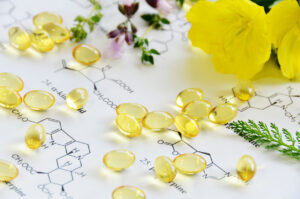Cyclical mastalgia and effective treatment can be sometimes simple and sometimes challenging for premenopausal women. This condition is also known as cyclic mastalgia or cyclic breast pain. It typically manifests as bilateral or unilateral breast discomfort, tenderness or swelling which usually peaks in severity just prior to menstruation and then subsides after. It is considered a benign and self-limiting condition, but it can be uncomfortable/painful enough to impair quality of life, exercise, and women can have a heightened anxiety about their breast health.
While cyclic mastalgia is prevalent and not related to breast cancer, the cause remains poorly understood and includes multifactorial mechanisms that likely contribute. Hormonal fluctuations, breast tissue sensitivity, inflammation, cyclic changes in breast anatomy, iodine insufficiency, psychological factors, nerve sensitivity and fibrocystic changes have all been explored in the research. Normal variations in hormonal fluctuations, particularly estrogen and progesterone levels during the menstrual cycle, are thought to play a central role in the development of cyclical breast pain. These hormonal changes can induce cyclic changes in breast tissue, including epithelial proliferation, fluid retention, and inflammation, leading to the cyclic breast pain symptoms. Some women’s breast tissue is then more sensitive to these normal hormonal changes.
 Evening primrose oil (EPO) is derived from the seeds of evening primrose plant. It is rich in gamma-linolenic acid (GLA), an omega-6 fatty acid with anti-inflammatory properties. It is thought that GLA modulates prostaglandin synthesis and promotes a balance of hormonal influence in the breasts, thus alleviating breast pain. Vitamin E may mitigate oxidative stress-induced inflammation in breast tissue.
Evening primrose oil (EPO) is derived from the seeds of evening primrose plant. It is rich in gamma-linolenic acid (GLA), an omega-6 fatty acid with anti-inflammatory properties. It is thought that GLA modulates prostaglandin synthesis and promotes a balance of hormonal influence in the breasts, thus alleviating breast pain. Vitamin E may mitigate oxidative stress-induced inflammation in breast tissue.
Previous studies have explored the efficacy of EPO and vitamin E in cyclical mastalgia, although the results are mixed. There has been little research exploring the combination of the two in treating cyclic mastalgia. The current study aimed to address this and was a randomized controlled trial evaluating the efficacy of EPO, vitamin E and the combination in alleviating cyclic breast pain.
Participants were at least 18 years, experienced cyclical mastalgia within the two weeks of onset of menses and relieved by menses, and present for at least two consecutive menstrual cycles. They had to have a pain score of at least 3 or greater. They were randomly assigned to one of four groups for a 6 month period. Group 1) Placebo Group 2) Vitamin E 400 mg (600 IU) once daily Group 3) EPO 1,000 mg bid Group 4) Combination EPO 1,000 mg bid and vitamin E 400 mg once daily.
The primary outcome measure was the change in breast pain, assessed using the modified McGill Pain Questionnaire at enrollment and at the end of the 6 months.
A total of 126 participants were randomized with a mean age of 38. A notable decrease in both the worst and average pain scores across all treatment groups was observed. The combined EPO/E group had the most substantial reduction in pain scores with changes of -4.0 those with the worst pain and
-3.7 for average pain. There were statistically significant differences among the treatment groups, confirming the superior effects of the combination EPO/E.
Commentary: Previous research on cyclical mastalgia with vitamin E, EPO or the combination has been inconsistent. The results of this study confirm the researcher’s hypothesis that a synergistic action of EPO and vitamin E may enhance the therapeutic effects. Their rationale seems plausible in that EPO, rich in GLA, exerts anti-inflammatory effects, whereas vitamin E functions as a potent antioxidant, reducing oxidative stress and inflammation in breast tissue. No testing of hormones or altering of hormones levels is needed to assess and treat cyclic mastalgia. The current study, along with any previous positive studies on EPO and vitamin E as single agents for this condition, demonstrate short term efficacy. What we don’t know from research, is if this can offer a sustainable effect after stopping the treatment after 6 months. In my clinical experience, using doses of EPO at 3,000-4,000 mg/day, or vitamin E at 400 mg/day or greater, most women can reduce the dose after 6 months and still have satisfactory results. Some women can discontinue altogether. So far, it has been a very individualized response, and strategy for long term relief. I always look at potential influential issues, such as other PMS/PMDD symptoms with a more comprehensive plan for those symptoms and their breast symptoms. Other influencers could be diets too high in fats, especially saturated fats, overweight/obesity, caffeine and sugar intake. Perimenopause women with newly acquired cyclic breast pain can also respond to addressing the broader perimenopause symptom picture. If perimenopause or menopause women acquire mastalgia due to taking systemic estrogen, this is not cyclic mastalgia, and the usual solution is lowering their dose of estrogen.
Reference: Kumari J, et al. Effectiveness of Evening Primrose and Vitamin E for Cyclical Mastalgia: A Prospective Study. Cureus. 2024 Apr; 16(4): e58055.

